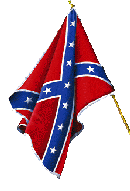
Monroe’s 1st/6th Arkansas Cavalry
![]()

Monroe’s 1st/6th Arkansas Cavalry
![]()
Officially designated by the State Military
Board as the 6th Regiment Arkansas Cavalry, it was almost never referred
to as such during the Civil War. It was usually called Monroe’s 1st
Arkansas Cavalry, occasionally the 4th Arkansas Cavalry, and more rarely
the 1st Trans-Mississippi Cavalry. It is also found in the Official
Records as Fagan’s Cavalry and Monroe’s Cavalry. The Compiled Service
Records of the men are filed under the designation, “1st (Monroe’s) Cavalry,”
Rolls 4 and 5.
The origins of Monroe’s Cavalry can be traced back to two smaller units, O’Neill’s 13th Battalion Arkansas Cavalry and Wheat’s Squadron Arkansas Cavalry. Captain James McCarney O’Neill was appointed to command the 13th Arkansas Battalion on August 1, 1862. It was composed of three independent troops: O’Neill’s (raised in Bradley county), Capt. Americus V. Rieff’s (raised in Hempstead county), and Capt. Columbus C. Wolfe’s (raised in Drew county). Capt. Patrick Henry Wheat’s squadron consisted of two Prairie county companies: Wheat’s and Raulston’s. In September 1862, these units were combined with other independent cavalry troops and partisan ranger companies to form the 6th (1st) Regiment Arkansas Cavalry. Colonel James Fleming Fagan was appointed to command the new regiment, with James Cade Monroe as lieutenant-colonel and James M. O’Neill as major. Fagan and Monroe had previously served together as colonel and lieutenant-colonel, respectively, of the famed 1st Arkansas Infantry.
Fagan was promoted to brigadier-general a month later, and Monroe succeeded him as colonel commanding the regiment. Monroe’s Cavalry took part in the battles of Cane Hill, Prairie Grove, Fayettevile, Backbone Mountain, Pine Bluff, Elkins Ferry, Poison Springs, and Marks’ Mills, in Arkansas; and in the many battles of Price’s 1864 Missouri Campaign, including Pilot Knob and Independence, Missouri; and Marais des Cygnes, Kansas. The regiment was operating in southwest Arkansas and northeast Texas at the end of the war. Monroe’s Cavalry never surrendered. Much of the regiment marched south towards the Rio Grande, with the intention of crossing into Mexico and somehow continuing the war. However, upon reaching the Trinity River, the soldiers voted to disband the regiment and return to their homes.
Rosters
Field
and Staff.
Company
A - Prairie county—Capt. Patrick H. Wheat.
Company
B - Bradley county—Capt. James M. McNeill.
Company
C - Hempstead county—Capt. George A. Davis.
Company
D - Hempstead county—Capt. Americus V. Rieff.
Company
E - Prairie county—Capt. W. E. Raulston.
Company
F - Clark county—Capt. John W. Hanson.
Company
G - Jefferson county—Capt. M. D. Davis.
Company
H - Saline county—Capt. G. W. Brown.
Company
I - Arkansas county—Capt. Young.
Company
K - Columbia county—Capt. Isaac L. Adair.
Company
L - Drew county—Capt. Columbus C. Wolfe.
If you have any questions or comments or if you would like to have more information about the Civil War and pension Records of the men who served in these Companies, contact me Jeri Helms Fultz or Bryan Howerton